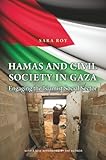Hamas and Civil Society in Gaza : Engaging the Islamist Social Sector / Sara Roy.
Material type: TextSeries: Princeton Studies in Muslim Politics ; 50Publisher: Princeton, NJ : Princeton University Press, [2013]Copyright date: ©2014Edition: With a New afterword by the authorDescription: 1 online resource (384 p.) : 2 mapsContent type:
TextSeries: Princeton Studies in Muslim Politics ; 50Publisher: Princeton, NJ : Princeton University Press, [2013]Copyright date: ©2014Edition: With a New afterword by the authorDescription: 1 online resource (384 p.) : 2 mapsContent type: - 9780691159676
- 9781400848942
- Arab-Israeli conflict
- Islamic fundamentalism -- Gaza Strip
- HISTORY / Middle East / General
- Christians
- Fatah
- Gaza City
- Gaza Strip
- Gaza strip
- Gaza
- Hamas
- Intifada
- Islam
- Islamic Resistance Movement
- Islamic authenticity
- Islamic civil society
- Islamic movement
- Islamist mobilization
- Islamist movement
- Islamist social institutions
- Islamist social sector
- Islamists
- Israel
- Jews
- Middle East
- Muslim Brotherhood
- Muslim community
- Oslo peace process
- Oslo period
- Oslo process
- Palestine
- Palestinian people
- Palestinian uprising
- Palestinians
- Second Intifada
- civic engagement
- civic restoration
- civism
- community development
- cultural identity
- grassroots development
- humanitarian supplies
- individual organizations
- non-Israeli
- political force
- political leadership
- political mobilization
- politics
- public sphere
- religion
- second Intifada
- secular civil society
- social institutions
- social sector work
- social system
- terrorist organization
- 324.25694208209531 23
- HV6433.P25 R69 2017
- online - DeGruyter
- Issued also in print.
| Item type | Current library | Call number | URL | Status | Notes | Barcode | |
|---|---|---|---|---|---|---|---|
 eBook
eBook
|
Biblioteca "Angelicum" Pont. Univ. S.Tommaso d'Aquino Nuvola online | online - DeGruyter (Browse shelf(Opens below)) | Online access | Not for loan (Accesso limitato) | Accesso per gli utenti autorizzati / Access for authorized users | (dgr)9781400848942 |
Frontmatter -- Contents -- Acknowledgments -- A Note on Language and Transliteration -- Prologue -- Chapter 1. Introduction: Structure, Arguments, and Conceptual Framework -- Chapter 2. A Brief History of Hamas and the Islamic Movement in Palestine -- Chapter 3. Islamist Conceptions of Civil Society -- Chapter 4. The Evolution of Islamist Social Institutions in the Gaza Strip -- Chapter 5. Islamist Social Institutions: Creating a Descriptive Context -- Chapter 6. Islamist Social Institutions: Key Analytical Findings -- Chapter 7. A Changing Islamist Order? From Civic Empowerment to Civic Regression-the Second Intifada and Beyond -- Postscript. The Devastation of Gaza-Some Additional Reflections on Where We Are Now -- Appendix. Islamist (and Non-Islamist) Social Institutions -- Afterword to the Paperback Edition -- Epilogue -- Notes -- Selected Bibliography -- Index
restricted access online access with authorization star
http://purl.org/coar/access_right/c_16ec
Many in the United States and Israel believe that Hamas is nothing but a terrorist organization, and that its social sector serves merely to recruit new supporters for its violent agenda. Based on Sara Roy's extensive fieldwork in the Gaza Strip and West Bank during the critical period of the Oslo peace process, Hamas and Civil Society in Gaza shows how the social service activities sponsored by the Islamist group emphasized not political violence but rather community development and civic restoration. Roy demonstrates how Islamic social institutions in Gaza and the West Bank advocated a moderate approach to change that valued order and stability, not disorder and instability; were less dogmatically Islamic than is often assumed; and served people who had a range of political outlooks and no history of acting collectively in support of radical Islam. These institutions attempted to create civic communities, not religious congregations. They reflected a deep commitment to stimulate a social, cultural, and moral renewal of the Muslim community, one couched not only--or even primarily--in religious terms. Vividly illustrating Hamas's unrecognized potential for moderation, accommodation, and change, Hamas and Civil Society in Gaza also traces critical developments in Hamas's social and political sectors through the Second Intifada to today, and offers an assessment of the current, more adverse situation in the occupied territories. The Oslo period held great promise that has since been squandered. This book argues for more enlightened policies by the United States and Israel, ones that reflect Hamas's proven record of nonviolent community building. In a new afterword, Roy discusses how Hamas has been affected by changing regional dynamics and by recent economic and political events in Gaza, including failed attempts at reconciliation with Fatah.
Issued also in print.
Mode of access: Internet via World Wide Web.
In English.
Description based on online resource; title from PDF title page (publisher's Web site, viewed 30. Aug 2021)


